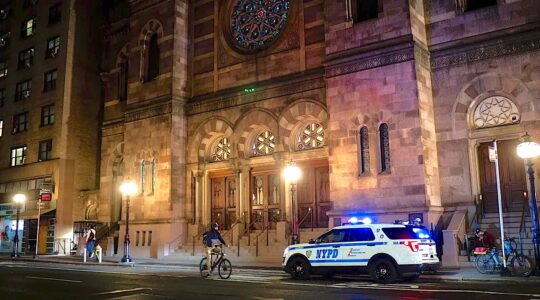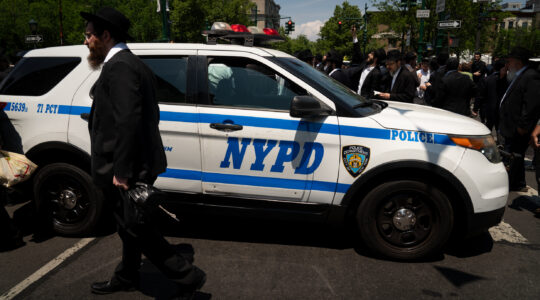Fargo, N.D. — The pioneer Jews who homesteaded on the flat, wind-whipped high plains at the turn of the last century came from foreign lands, beat back bone-rattling prairie winters and eked out a community in hardscrabble farming colonies near here.
They would have recognized a kindred spirit in Biana Shilshtut.
A pioneer in her own right, Shilshtut came to North Dakota State University two years ago from half a world away in Tashkent, Uzbekistan, the capital city in the foothills of the mountains of Central Asia.
A stranger in a strange land — one of endless prairie and a sky so big it’s as if God yawned — Shilshtut was determined not to let her Jewish heritage fall away even in heavily Lutheran Fargo. Even in a city lampooned as a frozen wasteland by a couple of Jewish brother filmmakers named Coen. Even in a city that has seen its share of neo-Nazi activity.
“I felt it was important not to lose what I obtained as a Jew in Uzbekistan,” Shilshtut said about what people here call her courageous and tireless outreach to closeted Jews at NDSU over the past year and a half. “I always knew I was Jewish, but before the fall of Communism I couldn’t express it or tell my friends.”
The Jews at North Dakota State, it turns out, weren’t all that different, afraid to open up for fear of sticking out. In fact, when Shilshtut began to hear from Jewish students in the fall of 2003, in response to a mass e-mail she had sent out to the university community, nearly all of them said they thought they were the only Jew on campus.
“It wasn’t just for me but for others’ Jewishness too that I reached out,” said Shilshtut, a striking 22-year-old whose dark brown hair and eyes stand out on a campus once jokingly referred to as “the school for the blonde.”
Shilshtut’s story of almost single-handedly nurturing a sense of Jewish identity at the school and creating a Hillel chapter in Fargo — likely the smallest in the world with only a handful of students — provides a sweet Midwestern counterpoint to the sour Mideast campus wars story that dominates the media spotlight at major universities on both coasts.
The issues for Jewish students out here on the plains, a thousand miles from either coast, tend to be simpler: finding a sense of their Jewishness, and holding on to it, in an overwhelmingly Christian environment; creating a sense of belonging almost out of whole cloth; spreading a little Jewishness and a sense of Jewish history across a campus little used to such a thing. The Israeli-Palestinian conflict and the battle over colleges divesting from companies that do business with Israel seem as far removed as a high plains horizon, or the nearest kosher restaurant, which is three hours away in Minneapolis.
The North Dakota State Hillel — it had about 10 students last year, losing four to graduation — is among the more unique. Shilshtut faced long odds in being able to create a chapter in a school that never had a real Jewish presence, and in a city whose only synagogue, the Reform Temple Beth El, has seen its membership fall from 150 in the 1950s to 30 or 40 closely-knit family units today.
The temple is led by lay spiritual leader Janeen Kobrinsky, who is much beloved here for nurturing Jewish life with a gentle hand. A baal teshuvah-turned-Reform Jew whose biblically inspired paintings hang in various spots around Fargo, Kobrinsky sits on the city’s Human Relations Commission and has worked to create a dialogue with Fargo’s wider religious community, conducting a Holocaust service at Concordia College, a Lutheran school here, and bringing Lutheran confirmation classes to Friday-night services.
Of Shilshtut’s work, Kobrinsky said, “Biana is quite something,” a smile crossing her face.
Support the New York Jewish Week
Our nonprofit newsroom depends on readers like you. Make a donation now to support independent Jewish journalism in New York.
When Jay Rubin of Hillel International, who had worked with Shilshtut when she was a student leader in Uzbekistan, heard of her plan to start a chapter in Fargo, he laughed.
“He told me, ‘You’ll have to be president, vice president, everything,’ ” Shilshtut recalled.
When Shilshtut finally convinced the university to let her send a mass e-mail to students and faculty looking for Jews to help her form a Jewish organization on campus, the computer technician in charge of such mailings also laughed, saying she would likely come up empty.
And when Shilshtut, in a desperate attempt to find a Havdalah set for her small band of believers, phoned an online seller from New York, a woman with an Israeli accent wondered aloud what someone in Fargo could possibly want with a Havdalah set.
Not only is the NDSU Hillel’s membership older than most — graduate students are part of the mix in the fledgling group — it has attracted a couple of Jews from Moorhead State University just across the Red River from Fargo in Moorhead, Minn., and several non-Jews.
Steven Dais, an NDSU senior who grew up as a Seventh-day Adventist and heard about Hillel from his comedy troupe partner Max Besner, has developed a deep affection for Judaism.
“I grew up keeping the Sabbath and eating clean and unclean meat,” Dais said. “I have a great respect for Judaism, and I’ve become more educated about the culture and customs.”
Dais has even been attending services at Temple Beth El.“There are beautiful symbols in Judaism,” he said.
For Besner, whose great-grandparents homesteaded in tiny Mott, N.D., and who was raised Reform in Minneapolis, joining Hillel has given the junior psychology major a stronger sense of his own Judaism, which had slipped away in his first two years here. Besner fields plenty of questions from his non-Jewish friends about Jewish holidays, and he says it’s been empowering.
“I feel like I’ve grown spiritually as a Jewish person outside of my community back home,” he said. “Religion teaches a moral structure that’s connected to the family. But now, even when I’m away from my family, I feel I’m a stronger person Jewishly.”
The New FargoThe emergence of the NDSU Hillel — however small and precariously perched — is in step with the university’s drive to become a more diverse and inclusive campus. In fact, the university and the city of Fargo itself are in a rush to counter a long-held perception as “white bread.”
While the rest of North Dakota has seen its population dwindle, Fargo’s is booming, jumping 20 percent in the last decade to more than 90,000. The downtown strip on Broadway is a hip mix of old and new, with a beautifully restored art deco movie house, high-end restaurants and the stylishly restored and art-filled Hotel Donaldson, the project that anchored the downtown renaissance.
Support the New York Jewish Week
Our nonprofit newsroom depends on readers like you. Make a donation now to support independent Jewish journalism in New York.
Like Fargo, NDSU has grown rapidly in recent years, up from an enrollment of 9,000 six years ago to more than 12,000 today. That growth has been spurred by President Joseph Chapman, whose wife, Gail, is Jewish and an active member of the Jewish community.
The school’s recently opened downtown campus, in a meticulously restored 100-year-old building, focuses on painting, printmaking, photography and architecture. It’s another boon to downtown.
On the main campus just north of downtown is a high-tech research park specializing in nanotechnology that university officials say is helping to change Fargo’s image. The university’s research expenditures have soared from $44.6 million in 1999 to more than $100 million in 2004.
And while the university is still overwhelmingly white, with a large Lutheran presence, university officials say they are putting into place recruitment strategies to increase the number of “people of color.” Now there are some 600 international students on campus and 500 domestic students of color, including 125 Native Americans.
That sense of a growing multiculturalism was tested last fall during a spate of anti-Semitic incidents that took place just after Rosh HaShanah. Four incidents — including a swastika and the words “Kill Jews” drawn in wet cement near the student union and neo-Nazi leaflets inserted in the campus newspaper — led to a well-attended sit-in against hate on campus and a quick denunciation by Chapman, who said he and the Fargo police believe the incidents were the work of a couple of high-school students and not an organized anti-Semitic effort. No arrests have been made.
While some in the Jewish community believe Chapman should have mentioned anti-Semitism directly in his statement, officials at the Jewish Community Relations Council for Minnesota and the Dakotas in Minneapolis say the university reacted quickly to “circle the wagons and get out the message that this won’t be tolerated here.”
Said Hillel’s faculty adviser Wendy Gordon, who teaches in the psychology department: “These were small-time acts and not seen as a real threat. The community really came out.”
Despite the efforts to create a more multicultural campus, it can get lonely for minorities. Shilshtut found that out firsthand when she arrived here in spring 2003.
“One of the reasons I reached out was because I was lonely,” she said. “I wanted some Jewish friends to hang out with, and I was determined not to give up.”
Some Jewish students believed they would have to put their Jewish identities on hold for their years at NDSU. Shilshtut changed that.
And Hillel has helped to change the climate on campus.
“Many of the students here come from rural backgrounds and this is the first time that they’ve ever met a Jewish or black person,” said Peg Furshong, who directs the university’s art gallery. “Having Hillel on campus humanizes the Jewish community and makes it real for these students.”
Support the New York Jewish Week
Our nonprofit newsroom depends on readers like you. Make a donation now to support independent Jewish journalism in New York.
Those on the Fargo campus have taken notice. The university’s Diversity Council recently honored Shilshtut with its Tapestry Award, given to students who contribute to the multiculturalism of the NDSU campus. Shilshtut’s photo hangs prominently in the student union alongside other Tapestry Award winners.
Looking at the photo, under which is a tapestry featuring a portion of the Uzbeki and Israeli flags, Shilshtut said, “This makes me feel like all of it was worthwhile.”
Holocaust Education
For three days last week, as spring was breaking here and the world was focused on a new pope, the NDSU campus was awash in Holocaust education.
Shilshtut, with an energy strikingly different from the laconic Midwestern style, has organized Shabbat dinners, Chanukah parties (bringing gelt and dreidels back from a trip to Winnipeg three hours away), Purim parties, Havdalah and break-the-fast get-togethers and Jewish movie nights. She has written grants to Hillel’s Soref Initiative, which funds campuses with tiny Jewish populations, and donned an apron at the annual community brunch run by Temple Beth El on April 17, which drew nearly 600 Fargoans, nearly all of them non-Jews.
And she has chronicled in pictures every event in the life of her Hillel — from the first Rosh HaShanah party to the most recent Purim party — her 5-by-7 photo album the most complete record of Jewish life on this campus likely ever assembled.
But the Holocaust programming this month may have been the most rewarding work Shilshtut has done here. As she gets ready to leave Fargo for a job with an investment firm in New York in a few weeks, the Holocaust effort is her parting gift to the NDSU campus, so that it might know a little of what it feels like to be Jewish and a minority that has beaten long odds to survive and thrive.
After the university approached Hillel about a Holocaust component for its diversity-inspired Civil Education Month, Shilshtut helped arrange for a program that included the showing of PBS’s new documentary “Auschwitz: Inside the Nazi State” over three Mondays and a riveting appearance by Dr. Robert Fisch, a survivor from Minneapolis, who spoke to some 300 rapt NDSU students about his harrowing experiences.
According to university officials, Shilshtut approached the Student Activities Office to create a Holocaust component to the university-wide “Boxes and Walls” exhibit, a series of experiential learning stations in the student union created by different minority student organizations on campus. Hillel created a mock concentration camp complete with a gas chamber, cramped bunk beds and boulders strewn about the floor to signify a work camp; students walked through the various stations to experience what Jews endured in the camps. The installation ended with panels detailing survivor testimonies and other examples of 20th century genocide, from Bosnia to Rwanda.
For Mary Rodenbiker, an NDSU sophomore from Rock Lake, N.D., “population 150 and shrinking,” who said she had never met a Jewish person, the exhibit was eye opening.
“This is the first time I’ve heard of this [Hillel] organization,” she said.
About the lesson of the Holocaust, Rodenbiker said, “I do have a sense that this could happen here, and that’s kind of scary.”
Support the New York Jewish Week
Our nonprofit newsroom depends on readers like you. Make a donation now to support independent Jewish journalism in New York.
As she watched scores of students stream into the exhibit, Shilshtut, her voice catching and her eyes moist, reflected on her time in Fargo.
“When I started this, I never imagined I could end up with something for the entire campus,” she said. “I feel like I’ve left a little bit of Jewish life on campus and now a few hundred students are coming to see it. It shows what four or five students can do.”
As Shilshtut flashed photos of students filing through the exhibit, chronicling another Hillel event for her photo album, she turned to a visitor and said proudly, “My job here is done.”
Worry About The FutureThe question on everyone’s lips in the Jewish community here — one that causes bowed heads and looks of worry — is what will happen to Jewish life at North Dakota State when Shilshtut leaves.
“Biana is definitely the engine that drove us,” said Isaac Kobrinsky, 29, son of the synagogue’s lay spiritual leader and a rock musician who teaches in the temple’s 26-student religious school.
“When I first met her she was proctoring a math exam I was taking. She came up to me and said, ‘Kobrinsky, I know your mother, you will join my Jewish group,’ ” the sophomore history major related, imitating Shilshtut’s strong Russian accent and her powers of persuasion. “Somebody will have to pick up the ball, but we’re here and we’re proud.”
“Things will slow down,” said Gordon, Hillel’s faculty adviser, who is expecting her first child soon. “Biana was a tornado, but we’ll try to maintain the basic activities.
“It’s easy to feel alone here as a Jewish student. We try to give them a religious home on campus. I do worry about her leaving,” she said, “but I think the core group will stay together.”
Abby Gold, a graduate student in communications, mother of two and treasurer of Temple Beth El, also worries. Gold, who came west from Massachusetts never believing she would be so involved in Jewish life here, said, “Biana has done such a good job joining the synagogue with the campus. We’ll have to try to keep the ties alive.”
In an irony Hillel members likely didn’t realize when Jewish movie night came around not long ago, they chose a Ben Stiller comedy about a rabbi and a priest in love with the same woman. She isn’t Jewish, which of course causes a crisis in the rabbi’s family.
There’s a different kind of crisis in the family, so to speak, for Fargo Jewry. With Biana Shilshtut — the “tornado” who blew through the Great Plains and breathed life into the community here — leaving for New York in a few weeks, the film’s title takes on a heavy symbolism for the Jewish students at North Dakota State and the wider Jewish community in the new Fargo. And the title is, for them, perhaps a fitting prayer for the future, as they carry on the Jewish presence brought here to the high plains by a hardy band of homesteaders from Russia more than a century ago: “Keeping the Faith.”
Next week: A look at the Hillel at Texas A&M University in College Station. Part of the travel expenses for this series were subsidized by Hillel: The Foundation for Jewish Campus Life.
Support the New York Jewish Week
Our nonprofit newsroom depends on readers like you. Make a donation now to support independent Jewish journalism in New York.
The New York Jewish Week brings you the stories behind the headlines, keeping you connected to Jewish life in New York. Help sustain the reporting you trust by donating today.




